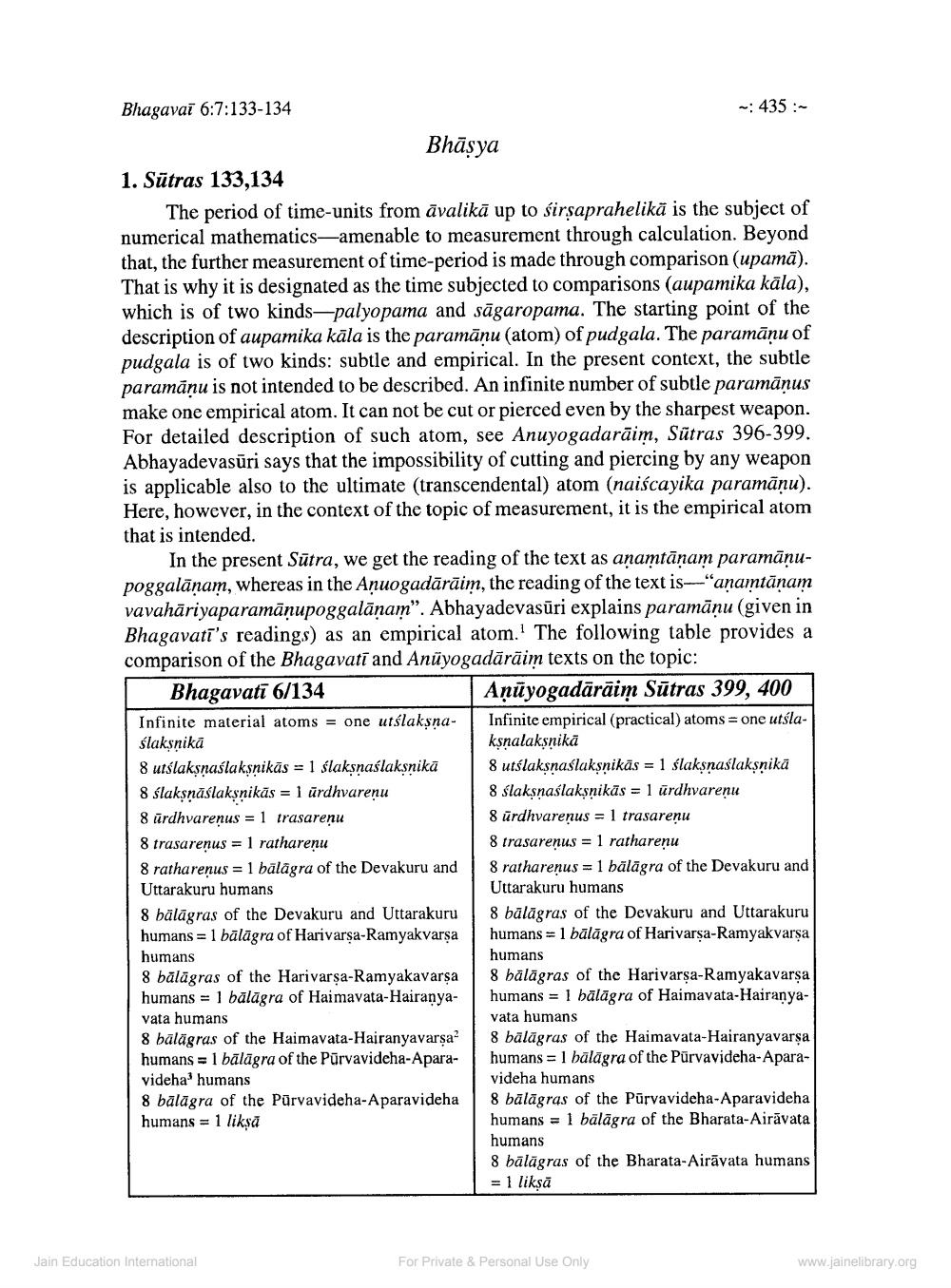________________
Bhagavai 6:7:133-134
- 435:Bhāsya 1. Sūtras 133,134
The period of time-units from āvalikā up to śirsaprahelikā is the subject of numerical mathematics—amenable to measurement through calculation. Beyond that, the further measurement of time-period is made through comparison (upamā). That is why it is designated as the time subjected to comparisons (aupamika kāla), which is of two kinds-palyopama and sāgaropama. The starting point of the description of aupamika kāla is the paramānu (atom) of pudgala. The paramāņu of pudgala is of two kinds: subtle and empirical. In the present context, the subtle paramānu is not intended to be described. An infinite number of subtle paramānus make one empirical atom. It can not be cut or pierced even by the sharpest weapon. For detailed description of such atom, see Anuyogadarāim, Sūtras 396-399. Abhayadevasūri says that the impossibility of cutting and piercing by any weapon is applicable also to the ultimate (transcendental) atom (naiścayika paramāņu). Here, however, in the context of the topic of measurement, it is the empirical atom that is intended.
In the present Sūtra, we get the reading of the text as anamtānam paramānupoggalānam, whereas in the Aņuogadārāim, the reading of the text is "anamtānam vavahāriyaparamāņupoggalānam". Abhayadevasūri explains paramānu (given in Bhagavati's readings) as an empirical atom. The following table provides a comparison of the Bhagavati and Anüyogadārāim texts on the topic: Bhagavati 6/134
Anüyogadārāim Sūtras 399, 400 Infinite material atoms = one utslaksna- Infinite empirical (practical) atoms = one utslaślaksnikā
ksnalakşnikā 8 utslaksnaślakṣnikās = 1 ślaksnaślaksnika 8 utslaksnaslaksnikās = 1 ślaksnaslaksnika 8 ślakṣnāšlaksnikās = 1 ürdhvarenu
8 Slaksnaślaksnikās = 1 urdhvarenu 8 ürdhvarenus = 1 trasareņu
8 urdhvarenus = 1 trasarenu 8 trasarenus = 1 ratharenu
8 trasarenus = 1 ratharenu 8 ratharenus = 1 bālāgra of the Devakuru and 8 ratharenus = 1 bālāgra of the Devakuru and Uttarakuru humans
Uttarakuru humans 8 bälāgras of the Devakuru and Uttarakuru 8 balāgras of the Devakuru and Uttarakuru humans = 1 bālāgra of Harivarşa-Ramyakvarsa humans = 1 bālāgra of Harivarşa-Ramyakvarsa humans
humans 8 bālāgras of the Harivarşa-Ramyakavarsa 8 bälägras of the Harivarsa-Ramyakavarsa humans = 1 bālāgra of Haimavata-Hairanya- humans = 1 bālāgra of Haimavata-Hairanyavata humans
vata humans 8 bälägras of the Haimavara-Hairanyavarşa? 8 bälägras of the Haimavata-Hairanyavarsa humans = 1 bālāgra of the Pūrvavideha-Apara- humans = 1 bālāgra of the Pūrvavideha-Aparavideha' humans
videha humans 8 balāgra of the Purvavideha-Aparavideha 8 bālāgras of the Pūrvavideha-Aparavideha humans = 1 liksā
humans = 1 bālāgra of the Bharata-Airāvata humans 8 bālägras of the Bharata-Airāvata humans = 1 liksā
Jain Education International
For Private & Personal Use Only
www.jainelibrary.org




